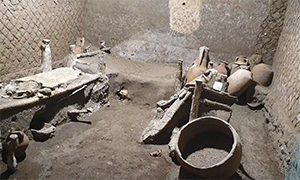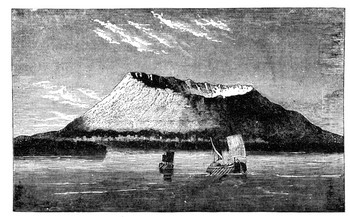|
Slave Quarters Found Intact at Pompeii
November 6, 2021
A Pompeii villa has again yielded new understanding centuries after it was destroyed. Archaeologists inspecting Civita Guiliana, a large villa not far from the ancient Italian city's northwest walls, found a set of slave quarters that were nearly intact. Among the finds in the small quarters were beds, pots, and a wooden chest in which were items of fabric and metal. It was at almost precisely noon on August 24, 79, that nearby Mount Vesuvius, a volcano that been quiet for hundreds of years, suddenly spewed forth a huge explosion that rocked the countryside for a huge The slave quarters measured 16 square meters (172 square feet) and had no wall decorations and only one light source, a small window in the upper part of one wall. In the quarters were three beds made of wood planks and rope; one bed was child-sized. Nearby were a few ceramic jugs and amphorae. Slaves were, in many ways, the backbone of the society of Ancient Rome. Estimates are that as many as 40 percent of the population in the Roman world were enslaved. Excavations at what was Pompeii and its surrounds have been ongoing for many years, and scores of archaeologists have reported many significant discoveries. Just last year, a dig in the same villa found the nearly perfectly preserved remains of two men, who were thought to be a wealthy man and his slave who tried to outrun the devastation. Another find in the same area in 2018 was a large horse, lying on its left side, and a harness made of iron and bronze. in a stables of the Casa dei Casti Amanti villa. |
|
Social Studies for Kids
copyright 2002–2024
David White




 number of miles around and creating a mushroom cloud of ash and debris 10 miles high. Fire and debris rained on Pompeii, and most people fled. A few, perhaps as many as 2,000, stayed, hoping that things wouldn't get any worse. It did. The very next morning, a cloud of toxic gas, fumes from the volcano, wafted through the city, killing all who breathed it. A rockslide followed, burying the dead where they lay.
number of miles around and creating a mushroom cloud of ash and debris 10 miles high. Fire and debris rained on Pompeii, and most people fled. A few, perhaps as many as 2,000, stayed, hoping that things wouldn't get any worse. It did. The very next morning, a cloud of toxic gas, fumes from the volcano, wafted through the city, killing all who breathed it. A rockslide followed, burying the dead where they lay.
